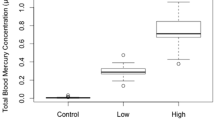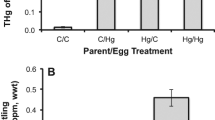Abstract
Behavioral effects resulting from exposure to dietary methylmercury (MeHg) have been reported in studies of several wildlife species. However, quantifying the impact of contaminant exposure on wild populations is complicated by the confounding effects of other environmental stressors. We controlled confounding stressors in a laboratory study to quantify the level of dietary MeHg exposure associated with negative effects on the fitness of captive-reared common loon (Gavia immer) chicks. We evaluated the effect of MeHg on loon chick behavior by employing several assays, including measures of righting reflexes, responsiveness to taped parental calls, reaction to frightening stimuli, and estimates of time activity budgets. Evidence suggested that as chicks aged, those exposed to nominal dietary dose levels of 0.4 and 1.2 μg Hg/g wet-weight in food (average estimated delivered dietary level of 0.55 and 1.94 μg Hg/g, respectively) were less likely (p < 0.01) to right themselves after being positioned on their backs during outdoor trials (≥37 days old) compared to chicks on the control diet. We detected differences (p < 0.05) in several response variables with respect to source of eggs. Chicks from nests on low-pH lakes tended to spend more time on resting platforms, spent less time in the shade, were more likely to walk across a platform upon release and do it quicker, were less responsive to a frightening stimulus, and exhibited less intense response to parental wail calls than did chicks from neutral pH-lakes. Rapid MeHg excretion during feather growth likely provides loon chicks protection from MeHg toxicity and may explain the lack of behavioral differences with dietary intake. Lake source effects suggest that in ovo exposure to MeHg or other factors related to lake pH have consequences on chick behavior.

Similar content being viewed by others
References
Aebischer NJ, Robertson PA, Kenward RE (1993) Compositional analysis of habitat use from animal radio-tracking data. Ecology 74:1313–1325
Altmann J (1974) Observational study of behavior: sampling methods. Behaviour 49:227–267
Barklow WE (1979) The function of variations in the vocalizations of the Common Loon (Gavia immer). Ph.D. Dissertation., Tufts University, Boston, MA, USA
Barr JF (1986) Population dynamics of the common loon (Gavia immer) associated with mercury-contaminated waters in north-western Ontario. Can Wildl Serv Occas Pap 56, 25 pp
Bouton SN, Frederick PC, Spalding MG, McGill H (1999) Effects of chronic, low concentrations of dietary methylmercury on the behavior of juvenile great egrets. Environ Toxicol Chem 18:1934–1939
Counard CJ (2001) Mercury exposure and effects on common loon (Gavia immer) behavior in the Upper Midwestern United States. M.S. Thesis, University of Minnesota, St. Paul, MN, USA
Eisler R (1987) Mercury hazards to fish, wildlife, and invertebrates: a synoptic review. US Fish Wildl Serv Biol Rep 85(1.10)
Evers DC, Kaplan JD, Meyer MW, Reaman PS, Braselton WE, Major A, Burgess N, Scheuhammer AM (1998) Geographic trend in mercury measured in common loon feathers and blood. Environ Toxicol Chem 17:173–183
Fevold BM, Meyer MW, Rasmussen PW, Temple SA (2003) Bioaccumulation patterns and temporal trends in mercury exposure in Wisconsin common loons. Ecotoxicol 12:83–93
Fournier F, Karasov WH, Kenow KP, Meyer MW, Hines RK (2002) The oral bioavailability and toxicokinetics of methylmercury in common loon (Gavia immer) chicks. Comp Biochem Physiol A 133:703–714
Haramis GM, Nice AD (1980) An improved web tagging technique for waterfowl. J Wildl Manag 44:898–899
Heinz GH (1975) Effects of methylmercury on approach and avoidance behavior of mallard ducklings. Bull Environ Contam Toxicol 13:554–564
Heinz GH (1976) Methylmercury: second-year feeding effects on mallard reproduction and duckling behavior. J Wildl Manag 40:82–90
Heinz GH (1979) Methylmercury: reproductive and behavioral effects on three generations of mallard ducks. J Wildl Manag 43:394–401
Heinz GH, Locke LN (1976) Brain lesions in mallard ducklings from parents fed methylmercury. Avian Dis 20:9–17
Hoffman DJ, Moore JM (1979) Teratogenic effects of external egg applications of methyl mercury in the mallard, Anas platyrhynchos. Teratology 20:453–462
Kenow KP, Gutreuter S, Hines RK, Meyer MW, Fournier F, Karasov WH (2003) Effects of methyl mercury exposure on the growth of juvenile common loons. Ecotoxicol 12:171–181
Kenow KP, Grasman KA, Hines RK, Meyer MW, Gendron-Fitzpatrick A, Spalding MG, Gray BR (2007a) Effects of methylmercury exposure on the immune function of juvenile common loons. Environ Toxicol Chem 26:1460–1469
Kenow KP, Meyer MW, Hines RK, Karasov WH (2007b) Distribution and accumulation of mercury in tissues and organs of captive-reared common loon (Gavia immer) chicks. Environ Toxicol Chem 26:1047–1055
Kenow KP, Hoffman DJ, Hines RK, Meyer MW, Bickham JW, Matson CW, Stebbins KR, Montagna P, Elfessi A (2008) Effects of methylmercury exposure on glutathione metabolism, oxidative stress, and chromosomal damage in captive-reared common loon (Gavia immer) chicks. Environ Pollut 156:732–738
Kenward MG, Roger JH (1997) Small sample inference for fixed effects from restricted maximum likelihood. Biometrics 53:983–997
Lipsitz SH, Kim K, Zhao L (1994) Analysis of repeated categorical data using generalized estimating equations. Stat Med 13:1149–1163
McIntyre JW (1988) The Common Loon: spirit of northern lakes. University of Minnesota Press, Minneapolis, MN, USA
Merrill EH, Hartigan JJ, Meyer MW (2005) Does prey biomass or mercury exposure affect loon chick survival in Wisconsin? J Wildl Manag 69:57–67
Meyer MW, Evers DC, Daulton T, Braselton WE (1995) Common loons (Gavia immer) nesting on low pH lakes in northern Wisconsin have elevated blood mercury content. Water Air Soil Pollut 80:871–880
Meyer MW, Evers DC, Hartigan JJ, Rasmussen PS (1998) Patterns of Common Loon (Gavia immer) mercury exposure, reproduction, and survival in Wisconsin, USA. Environ Toxicol Chem 17:184–190
Miller ME, Davis CS, Landis JR (1993) The analysis of longitudinal polytomous data: generalized estimating equations and connections with weighted least squares. Biometrics 49:1033–1044
Nocera JJ, Taylor PD (1998) In situ behavioral response of common loons associated with elevated mercury (Hg) exposure. Conserv Ecol. 2: article 10. http://www.consecol.org/vol2/iss2/art10/
Pollentier CD, Kenow KP, Meyer MW (2007) Common loon (Gavia immer) eggshell thickness and egg volume vary with acidity of nest lake in northern Wisconsin. Waterbirds 30:367–374
Rummel L, Goetzinger C (1978) Aggressive display in the Common Loon. Auk 95:183–196
SAS Institute (2003) SAS OnlineDoc® 9.1. Cary, NC, USA
SAS Institute (2005) SAS OnlineDoc® 9.1 for the GLIMMIX Procedure. Cary, NC, USA
Scheuhammer AM (1991) Effects of acidification on the availability of toxic metals and calcium to wild birds and mammals. Environ Pollut 71:329–375
Scheuhammer AM, Blancher P (1994) Potential risk to common loons (Gavia immer) from methylmercury exposure in acidified lakes. Hydrobiologia 279/280:445–455
Shimai S, Satoh H (1985) Behavioral teratology of methylmercury. J Toxicol Sci 10:199–216
Sjolander S, Agren G (1972) Reproductive behavior of the Common Loon. Wilson Bul 84:296–308
Spalding MG, Frederick PC, McGill HC, Bouton SN, McDowell LR (2000) Methylmercury accumulation in tissues and its effects on growth and appetite in captive great egrets. J Wildl Dis 36:411–422
Thompson DR (1996) Mercury in birds and mammals. In: Beyer WN, Heinz GH, Redmon-Norwood AW (eds) Environmental contaminants in wildlife: interpreting tissue concentrations. Lewis, Boca Raton, FL, USA, pp 341–356
US Environmental Protection Agency (1996) Mercury in solid or semisolid waste (manual cold-vapor technique). Method 7471A. Test methods for evaluating solid waste, physical/chemical methods. SW846. Office of Solid Waste, Washington, DC
Watanabe C, Satoh H (1996) Evolution of our understanding of methylmercury as a health threat. Environ Health Perspect 104:367–379
Weiner JG (1987) Metal contamination of fish in low-pH lakes and potential implications for piscivorous wildlife. Trans N Am Wildl Nat Resour Conf 52:645–657
Wolfe MF, Schwarzbach S, Sulaiman RA (1998) Effects of mercury on wildlife: a comprehensive review. Environ Toxicol Chem 17:146–160
Young KE (1983) Seasonal and temporal patterning of Common Loon (Gavia immer) vocalizations. M.S. Thesis, Syracuse University, Syracuse, NY, USA
Acknowledgements
Financial support for this project was provided by the Electric Power Research Institute, the Wisconsin Utilities Association, the Wisconsin Department of Administration Wisconsin Focus on Energy Environmental Research Program, the Wisconsin Department of Natural Resources, and the U.S. Geological Survey. We thank the following individuals for their assistance: F. Fournier, J.E. Lyon, K.A. Kroc, M.S. Meier, A.J. Lindo, M.L. Weinandt, R.L. Beckmann, L.E. McColl, S.M. Strom, E.R. Deppe, D.D. King, C.M. Lipke, H.L. O’Brien, S.T. Troxell, R.M. Kreiling, A. Stone, T.N. Willers, K.A. Zinszer, E.A. Kurth, K.M. McColl, A.M. Hankee, K.A. DuBois, E.L. Strom, L.L Meek, S.C. Houdek, C.D. Pollentier, A.J. Kimball, J.L. Inglish, J.A. Homyack, B.A. Rycyzyn, C.R. Gonczy, T. Daulton, B. Fevold, S. Gillum, M. Parrara, S. Weick, L.A. Lee, J. Luoma, C.A. Berg, D.M. Kennedy, T.D. Hubert, L.G. Johnson, E. Lavoie, and K. Day.
Author information
Authors and Affiliations
Corresponding author
Rights and permissions
About this article
Cite this article
Kenow, K.P., Hines, R.K., Meyer, M.W. et al. Effects of methylmercury exposure on the behavior of captive-reared common loon (Gavia immer) chicks. Ecotoxicology 19, 933–944 (2010). https://doi.org/10.1007/s10646-010-0475-2
Accepted:
Published:
Issue Date:
DOI: https://doi.org/10.1007/s10646-010-0475-2




